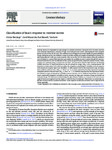Classification of beach response to extreme storms
| dc.contributor.author | Burvingt, Olivier | |
| dc.contributor.author | Masselink, Gerd | |
| dc.contributor.author | Russell, Paul | |
| dc.contributor.author | Scott, Tim | |
| dc.date.accessioned | 2017-11-20T09:36:12Z | |
| dc.date.available | 2017-11-20T09:36:12Z | |
| dc.date.issued | 2017-10-15 | |
| dc.identifier.issn | 0169-555X | |
| dc.identifier.issn | 1872-695X | |
| dc.identifier.other | C | |
| dc.identifier.uri | http://hdl.handle.net/10026.1/10214 | |
| dc.description | publisher: Elsevier articletitle: Classification of beach response to extreme storms journaltitle: Geomorphology articlelink: http://dx.doi.org/10.1016/j.geomorph.2017.07.022 content_type: article copyright: Crown Copyright © 2017 Published by Elsevier B.V. | |
| dc.description.abstract |
Extreme storms are responsible for rapid changes to coastlines worldwide. During the 2013/14 winter, the west coast of Europe experienced a sequence of large, storm-induced wave events, representing the most energetic period of waves in the last 60 years. The southwest coast of England underwent significant geomorphological change during that period, but exhibited a range of spatially variable and complex morphological responses, despite being subjected to the same storm sequence. Here, we use the 2013/14 storm response along the southwest coast of England as a natural field laboratory and explain this variability in storm response through the introduction and evaluation of a new classification of how sandy and gravel beaches respond to extreme storms. Cluster analysis was conducted using an unique data set of pre- and post-storm airborne Light Detection and Ranging (LiDAR) data from 157 beach sites based on the net volumetric change (dQnet) and a novel parameter, the longshore variation index (LVI) which quantifies the alongshore morphological variability in beach response. Four main beach response types were identified: (1) fully exposed beaches that experienced large and alongshore uniform sediment losses (dQnet ≈ 100 m3·m− 1); (2) semi-exposed beaches that experienced medium alongshore uniform sediment losses (dQnet ≈ 50 m3·m− 1); (3) sheltered short beaches that experienced limited net sediment change and alongshore variability in beach response; and (4) sheltered long beaches that experienced considerable alongshore variability in beach response and large gross sediment change, but limited net sediment change. The key factors in determining the type of beach response are: exposure to the storm waves, angle of storm wave approach and the degree to which the beach is embayed. These factors are universally applicable on many exposed coastlines worldwide, so the response classification presented here is expected to be widely applicable. | |
| dc.format.extent | 722-737 | |
| dc.language | en | |
| dc.language.iso | en | |
| dc.publisher | Elsevier BV | |
| dc.subject | Storm response | |
| dc.subject | Beach morphodynamics | |
| dc.subject | Beach classification | |
| dc.subject | LiDAR | |
| dc.subject | Exposed beaches, sheltered beaches | |
| dc.subject | Beach rotation | |
| dc.title | Classification of beach response to extreme storms | |
| dc.type | journal-article | |
| dc.type | Journal Article | |
| plymouth.author-url | https://www.webofscience.com/api/gateway?GWVersion=2&SrcApp=PARTNER_APP&SrcAuth=LinksAMR&KeyUT=WOS:000413175000052&DestLinkType=FullRecord&DestApp=ALL_WOS&UsrCustomerID=11bb513d99f797142bcfeffcc58ea008 | |
| plymouth.volume | 295 | |
| plymouth.publication-status | Accepted | |
| plymouth.journal | Geomorphology | |
| dc.identifier.doi | 10.1016/j.geomorph.2017.07.022 | |
| plymouth.organisational-group | /Plymouth | |
| plymouth.organisational-group | /Plymouth/Admin Group - REF | |
| plymouth.organisational-group | /Plymouth/Admin Group - REF/REF Admin Group - FoSE | |
| plymouth.organisational-group | /Plymouth/Faculty of Science and Engineering | |
| plymouth.organisational-group | /Plymouth/Faculty of Science and Engineering/School of Biological and Marine Sciences | |
| plymouth.organisational-group | /Plymouth/REF 2021 Researchers by UoA | |
| plymouth.organisational-group | /Plymouth/REF 2021 Researchers by UoA/UoA07 Earth Systems and Environmental Sciences | |
| plymouth.organisational-group | /Plymouth/Research Groups | |
| plymouth.organisational-group | /Plymouth/Research Groups/Marine Institute | |
| plymouth.organisational-group | /Plymouth/Users by role | |
| plymouth.organisational-group | /Plymouth/Users by role/Academics | |
| plymouth.organisational-group | /Plymouth/Users by role/Researchers in ResearchFish submission | |
| dcterms.dateAccepted | 2017-07-25 | |
| dc.identifier.eissn | 1872-695X | |
| dc.rights.embargoperiod | Not known | |
| rioxxterms.versionofrecord | 10.1016/j.geomorph.2017.07.022 | |
| rioxxterms.licenseref.uri | http://www.rioxx.net/licenses/all-rights-reserved | |
| rioxxterms.licenseref.startdate | 2017-10-15 | |
| rioxxterms.type | Journal Article/Review | |
| plymouth.funder | Physical and biological dynamic coastal processes and their role in coastal recovery (BLUE-coast)::NERC | |
| plymouth.funder | Physical and biological dynamic coastal processes and their role in coastal recovery (BLUE-coast)::NERC |


